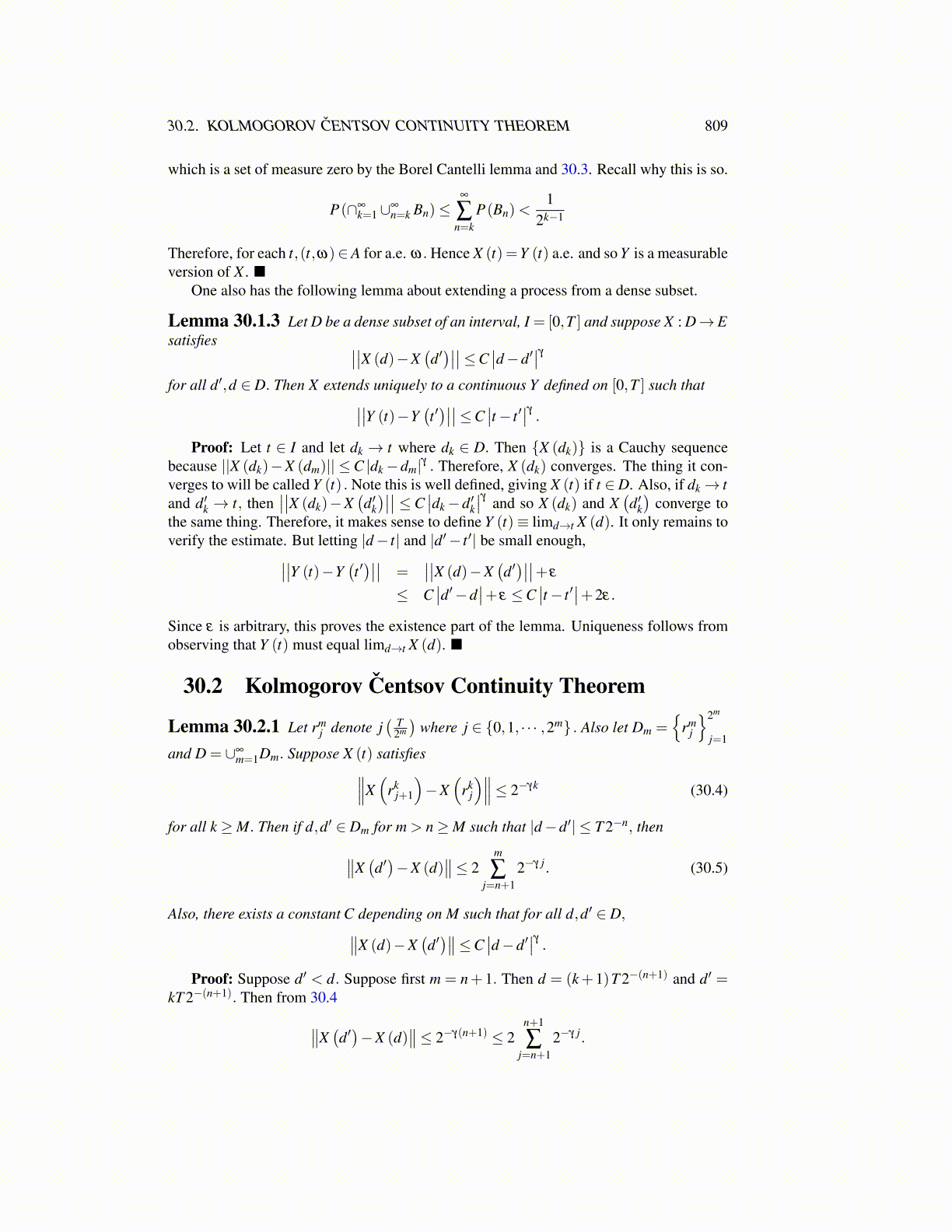
30.2. KOLMOGOROV ČENTSOV CONTINUITY THEOREM 809
which is a set of measure zero by the Borel Cantelli lemma and 30.3. Recall why this is so.
P(∩∞k=1∪∞
n=k Bn)≤∞
∑n=k
P(Bn)<1
2k−1
Therefore, for each t,(t,ω)∈A for a.e. ω. Hence X (t) =Y (t) a.e. and so Y is a measurableversion of X . ■
One also has the following lemma about extending a process from a dense subset.
Lemma 30.1.3 Let D be a dense subset of an interval, I = [0,T ] and suppose X : D→ Esatisfies ∣∣∣∣X (d)−X
(d′)∣∣∣∣≤C
∣∣d−d′∣∣γ
for all d′,d ∈ D. Then X extends uniquely to a continuous Y defined on [0,T ] such that∣∣∣∣Y (t)−Y(t ′)∣∣∣∣≤C
∣∣t− t ′∣∣γ .
Proof: Let t ∈ I and let dk → t where dk ∈ D. Then {X (dk)} is a Cauchy sequencebecause ||X (dk)−X (dm)|| ≤C |dk−dm|γ . Therefore, X (dk) converges. The thing it con-verges to will be called Y (t) . Note this is well defined, giving X (t) if t ∈D. Also, if dk→ tand d′k → t, then
∣∣∣∣X (dk)−X(d′k)∣∣∣∣ ≤ C
∣∣dk−d′k∣∣γ and so X (dk) and X
(d′k)
converge tothe same thing. Therefore, it makes sense to define Y (t)≡ limd→t X (d). It only remains toverify the estimate. But letting |d− t| and |d′− t ′| be small enough,∣∣∣∣Y (t)−Y
(t ′)∣∣∣∣ =
∣∣∣∣X (d)−X(d′)∣∣∣∣+ ε
≤ C∣∣d′−d
∣∣+ ε ≤C∣∣t− t ′
∣∣+2ε.
Since ε is arbitrary, this proves the existence part of the lemma. Uniqueness follows fromobserving that Y (t) must equal limd→t X (d). ■
30.2 Kolmogorov Čentsov Continuity Theorem
Lemma 30.2.1 Let rmj denote j
( T2m
)where j ∈ {0,1, · · · ,2m} . Also let Dm =
{rm
j
}2m
j=1and D = ∪∞
m=1Dm. Suppose X (t) satisfies∥∥∥X(
rkj+1
)−X
(rk
j
)∥∥∥≤ 2−γk (30.4)
for all k ≥M. Then if d,d′ ∈ Dm for m > n≥M such that |d−d′| ≤ T 2−n, then∥∥X(d′)−X (d)
∥∥≤ 2m
∑j=n+1
2−γ j. (30.5)
Also, there exists a constant C depending on M such that for all d,d′ ∈ D,∥∥X (d)−X(d′)∥∥≤C
∣∣d−d′∣∣γ .
Proof: Suppose d′ < d. Suppose first m = n+ 1. Then d = (k+1)T 2−(n+1) and d′ =kT 2−(n+1). Then from 30.4∥∥X
(d′)−X (d)
∥∥≤ 2−γ(n+1) ≤ 2n+1
∑j=n+1
2−γ j.